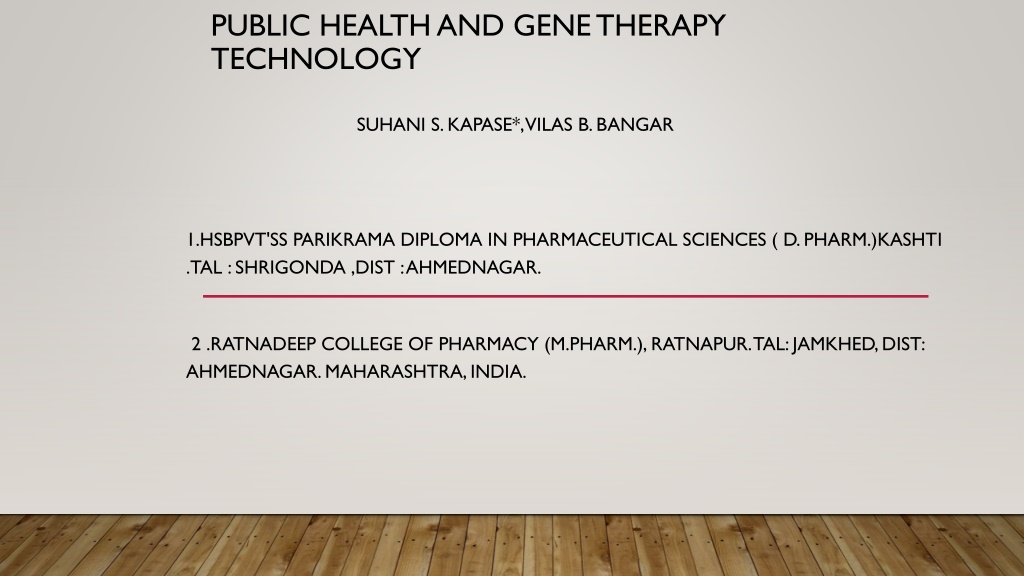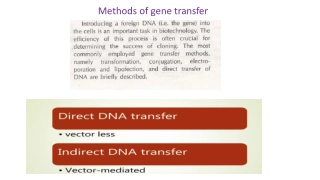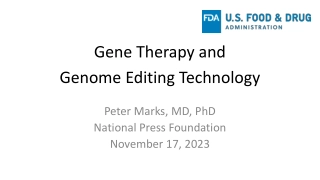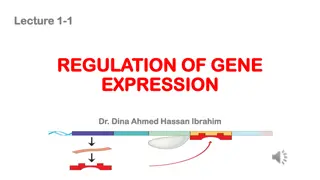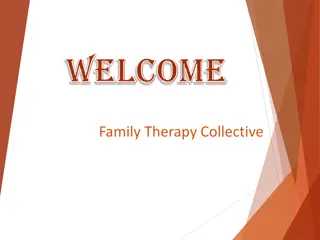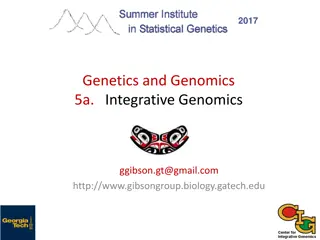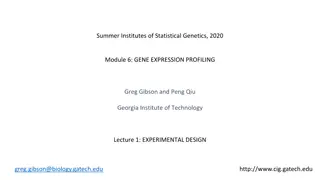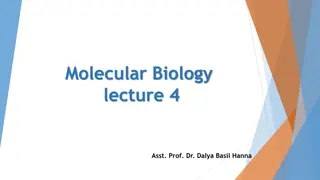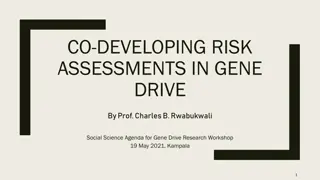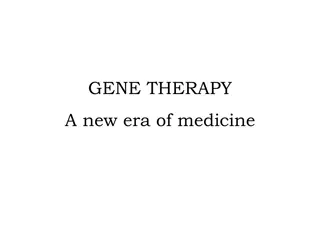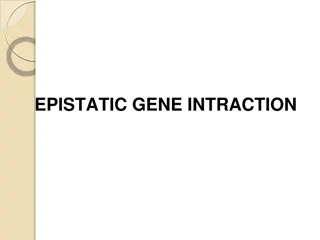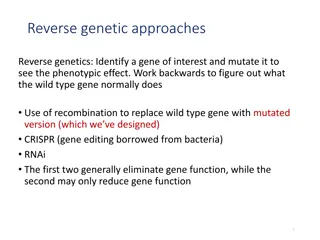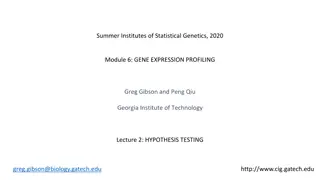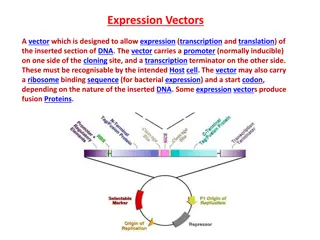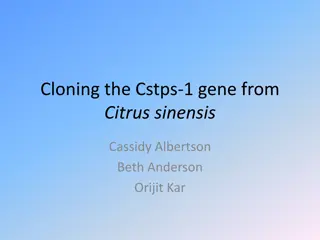PUBLIC HEALTH AND GENE THERAPY TECHNOLOGY
A novel approach to treat, cure, or prevent disease by changing a person's gene expression through gene therapies which aims at modifying the genetic makeup of individuals. This innovative field involves deliberate gene modification to restore normal cell functioning and tissue repair. Explore the symbiotic relationship between public health and the transformative potential of gene therapy technology, focusing on customized therapies, interventions, and disease prevention tactics.
Download Presentation

Please find below an Image/Link to download the presentation.
The content on the website is provided AS IS for your information and personal use only. It may not be sold, licensed, or shared on other websites without obtaining consent from the author.If you encounter any issues during the download, it is possible that the publisher has removed the file from their server.
You are allowed to download the files provided on this website for personal or commercial use, subject to the condition that they are used lawfully. All files are the property of their respective owners.
The content on the website is provided AS IS for your information and personal use only. It may not be sold, licensed, or shared on other websites without obtaining consent from the author.
E N D
Presentation Transcript
PUBLIC HEALTH AND GENE THERAPY TECHNOLOGY SUHANI S. KAPASE*, VILAS B. BANGAR 1.HSBPVT'SS PARIKRAMA DIPLOMA IN PHARMACEUTICAL SCIENCES ( D. PHARM.)KASHTI .TAL : SHRIGONDA ,DIST : AHMEDNAGAR. 2 .RATNADEEP COLLEGE OF PHARMACY (M.PHARM.), RATNAPUR. TAL: JAMKHED, DIST: AHMEDNAGAR. MAHARASHTRA, INDIA.
INTRODUCTION: A novel approach to treat, cure, or ultimately prevent disease by changing a person's gene expression" is how the American Medical Association describes gene therapies. Although these therapies are a novel approach to treating genetic disorders, including uncommon and complex diseases, they are still in the early stages of development both in the healthcare system .This innovative field revolves around the deliberate modification of an individual's genes to treat or prevent disorders, presenting a paradigm shift from traditional therapeutic approaches. With the evolution of cutting-edge technologies like CRISPR- Cas9, AAVs, and lentiviruses, the precision and feasibility of gene therapy have reached unprecedented levels. This introduction explores the diverse technologies employed, ethical considerations, and the crucial interplay between public health and the implementation of gene therapy..Gene therapy attempts to restore the normal functioning of cells and tissues in a patient by changing, repairing, or replacing damaged genes in their body.
Public health is a dynamic field dedicated to safeguarding and improving the well-being of communities. As we delve into the 21st century, the intersection of public health and gene therapy technology presents a groundbreaking frontier. Gene therapy, a revolutionary approach aimed at treating or preventing diseases by modifying the genetic makeup of individuals, holds immense promise for transforming healthcare outcomes. Join me on this exploration of the symbiotic relationship between public health and the transformative potential of gene therapy technology. We are setting out on a path toward customized therapies, focused interventions, and the possible reinterpretation of disease prevention tactics as we investigate the potential synergies between gene therapy and public health. Come explore the developments and effects of this state-of-the-art technology on how healthcare will evolve in the future.
Gene therapy encompasses a spectrum of strategies aimed at correcting, replacing, or regulating genes to treat or prevent diseases. Here's a more detailed exploration: 1.Technological Landscape: - CRISPR-Cas9:Known for its accuracy, efficiency, and versatility in gene editing, CRISPR-Cas9 allows researchers to precisely modify DNA sequences. -Viral Vectors:AAVs and lentiviruses are commonly used as carriers to deliver therapeutic genes into target cells. They efficiently transport genetic material without causing disease. 2. Applications: - Monogenic Disorders: Gene therapy shows promise in treating diseases caused by a single gene mutation, such as cystic fibrosis and sickle cell anaemia. - Cancer: Immunotherapy, a form of gene therapy, enhances the immune system's ability to target and destroy cancer cells.
3. Challenges and Ethical Considerations: - Off-Target Effects: Ensuring the precision and safety of gene-editing tools remains a challenge. - Informed Consent: The ethical implications of altering the human genome raise questions about informed consent and long-term consequences. 4. Public Health Integration: - Equitable Access: Public health initiatives play a crucial role in ensuring widespread and equitable access to gene therapies. - Regulatory Frameworks: Establishing ethical and legal frameworks is essential to guide the responsible development and implementation of gene therapy.
Gene therapy drugs: Currently, the majority of conventional drug targets are proteins, like enzyme inhibitors and antibodies, that are expressed by genes that cause disease. On the other hand, gene therapy medications hold a broad position in clinical treatment because they have the ability to modify gene transcription and translation processes at the DNA or mRNA level. Several of the most extensively researched gene therapy medications will be covered in this section, including plasmid DNA (pDNA), siRNA, miRNA, ASO, CRISPR/Cas9, and similar ones.
CRISPR-Cos-9: Based on plasmid, RNA, and protein, the CRISPR/Cas9 system is currently delivered at three different levels. Delivery of mRNA encoding Cas9 protein has a lower off-target rate than delivery plasmid; direct delivery of Cas9 protein has low immunogenicity; delivery of plasmids encoding Cas9 protein and sgRNA requires fewer transfections, making it convenient and stable. The low cost and ease of use of the pDNA-based CRISPR/Cas9 system have made it a very appealing tool.
Other gene therapy drug: The hairpin structure of shRNA is formed by a stem-loop sequence located in the middle of two short inverted repeats. Through virus-mediated transduction, shRNA maintains its stability with a comparatively high viral infection efficiency. The cell's Dicer enzyme is used to initiate nucleus-wide gene silencing following transduction. In contrast to siRNA, it has a longer-lasting and more potent curative effect, but its transfection efficiency is lower and its preparation takes longer. Zhang et al. treated pancreatic fibrosis by inducing pancreatic stellate cells' mitochondrial apoptosis and delivering TLR4 shRNA (VA-lip-shRNA-TLR4) via cationic liposomes
